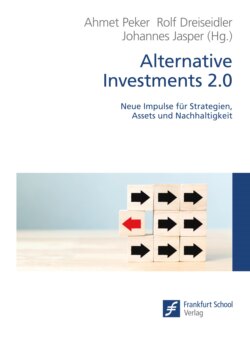Читать книгу Alternative Investments 2.0 - Группа авторов - Страница 38
На сайте Литреса книга снята с продажи.
Exhibit 7: Benefits of Co-Investments
ОглавлениеSource: Preqin, StepStone Private Debt Internal Database
Like co-investments, secondaries provide many financial benefits. In a secondary transaction, an investor will buy a portfolio of seasoned loans, thereby reducing the overall deployment duration and ensuring a faster turnaround on distributions and higher returns. In addition, it is usually possible to buy secondary portfolios at a discount to the net asset value (NAV), which creates immediate value for LPs. Discounts can come about for a number of reasons including from sellers who require immediate liquidity.
Currently, the secondary volume in private debt is quite small, but as the asset class matures, we expect secondary volumes to grow and follow a path not unlike the one laid out by private equity. The COVID-19 crisis may act as a short-term catalyst for secondary transactions. Were prices in public markets to drop for an extended period, some LPs may be forced to sell part of their private market exposure to remain in line with their asset allocation guidelines. For levered portfolios, a deterioration in fundamentals may trigger margin calls by lenders and hence the need to sell assets to raise cash.
Investors ramping up their private debt exposure or with less stringent constraints will benefit from this selling pressure. A growing set of opportunities will also allow potential buyers to be more selective and better diversify their secondary portfolio. In addition to the financial benefits, co-investments and secondaries enable the LP to more thoroughly vet the GP’s investment insight, and to gain a better understanding of a GP’s capabilities and style. For the GP, co-investments and secondaries provide an opportunity to showcase its skill set and, if all goes well, persuade the LP to commit to a future fund.
Given the many benefits of co-investments and secondaries, why do most LPs not participate? For co-investments, speed is the biggest obstacle. Most private debt deals are finalized within two to three weeks. Unless the LP has a dedicated co-investment team, it is not equipped to make investment decisions that quickly. Though many LPs may mention the desire for co-investments when discussing a commitment to one of the GP’s funds, they are rarely able to execute when the opportunity arises. For secondaries, LPs need to have the ability to analyse many loans in a short period of time, which may also require a dedicated team.
While the intangible benefits of co-investments to both LPs and GPs are clear, debate over the actual results continues. Academic research, including a study by Fang/Ivashina/Lerner (2015),[8] raises significant questions about the performance of co-investments, specifically a concern about adverse selection. In a white paper[9] published in 2014, StepStone demonstrated that co-investment deals generally performed in line with their parent funds on a gross basis, outperformed them on a net basis, and, on average, had lower risk profiles than their parent funds.
This analysis suggests that GPs actually had higher conviction in the co-investment deals and they were not simply “selling down risk”. Therefore, the performance comparison shows that the adverse selection concern in co-investing may be overstated. Thus, compelling returns are achievable in co-investing as long as the co-investment program incorporates processes and structures to mitigate the risks associated with co-investing.
LPs source co-investments and secondaries through their primary private debt manager relationships. The key to creating a diversified co-investment portfolio is to see many co-investment opportunities. This is important for three reasons:
Selectivity matters: GPs typically review 1,000 transactions per year, but close on only between 3% and 5%.[10] A strong co-investment “flow” helps LPs to be equally selective.
LPs gain knowledge of the current deal environment and are able to better distinguish between “good” and “bad” deals.
With good “flow” LPs will be able to create more diversified portfolios.
As a result, the key to creating a strong co-investment portfolio is to have significant scale and be a meaningful partner to many GPs. This can be challenging given that private debt has fewer managers than private equity. To make the most of this situation, investors might rely on an adviser with the reach and scale necessary to cover the global private debt market.
Although each secondary and co-investment opportunity has its own idiosyncrasies, which engender a certain level of customization, there are several analyses that should be part of any investment due diligence. In light of how time sensitive these transactions can be, drilling down into these five criteria may be helpful to LPs as they decide whether to proceed:
covenants (see also section 6),
control/lender of record (see also section 6),
EBITDA adjustments (see also section 2.2.4),
leverage levels & Loan-to-Value (LTV) ratios,
gross asset yield.
High equity cushions and low LTV ratios are tantamount to “skin in the game” for private debt managers. These metrics provide powerful insight into whether the lead sponsors will be properly aligned with their co-investors. If equity cushions are too low and leverage is too high, sponsors may not be as patient as they otherwise might be during a market correction. A high LTV ratio, on the other hand, may be evidence that the GPs’ underwriting standards are too lax, and they are willing to take unnecessary risks to boost returns.
The gross asset yield of an investment considers both the coupon and the closing fees paid by the borrower to the lenders. Though co-investors are typically entitled to receive the closing fee, they should be mindful of “skimming” – the practice of shaving one or two points off the Original Issue Discount (OID). This skim is similar to the origination fee banks charge for bearing the risk that syndication implies.
